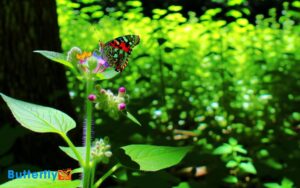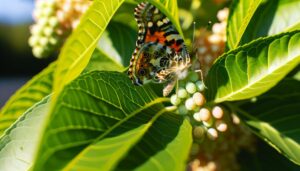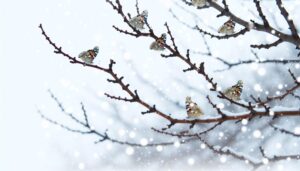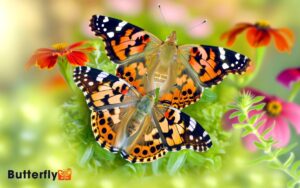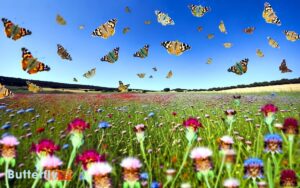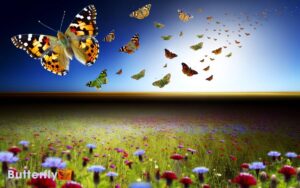How Long Does the Painted Lady Butterfly Live? 2 to 4 Weeks!
The Painted Lady Butterfly (Vanessa cardui) lives approximately 2 to 4 weeks as an adult. Prior to adulthood, the species goes through several stages: the egg stage lasts a few days, the larval stage spans 7 to 11 days, and the pupal stage takes 7 to 10 days.
Factors like temperature, humidity, and predation influence the total duration of these stages. Adults are primarily involved in mating and egg laying, with their lifespan affected by environmental conditions.
This detailed lifecycle weaves together critical aspects of development, offering more insights on how these butterflies thrive in their habitats.
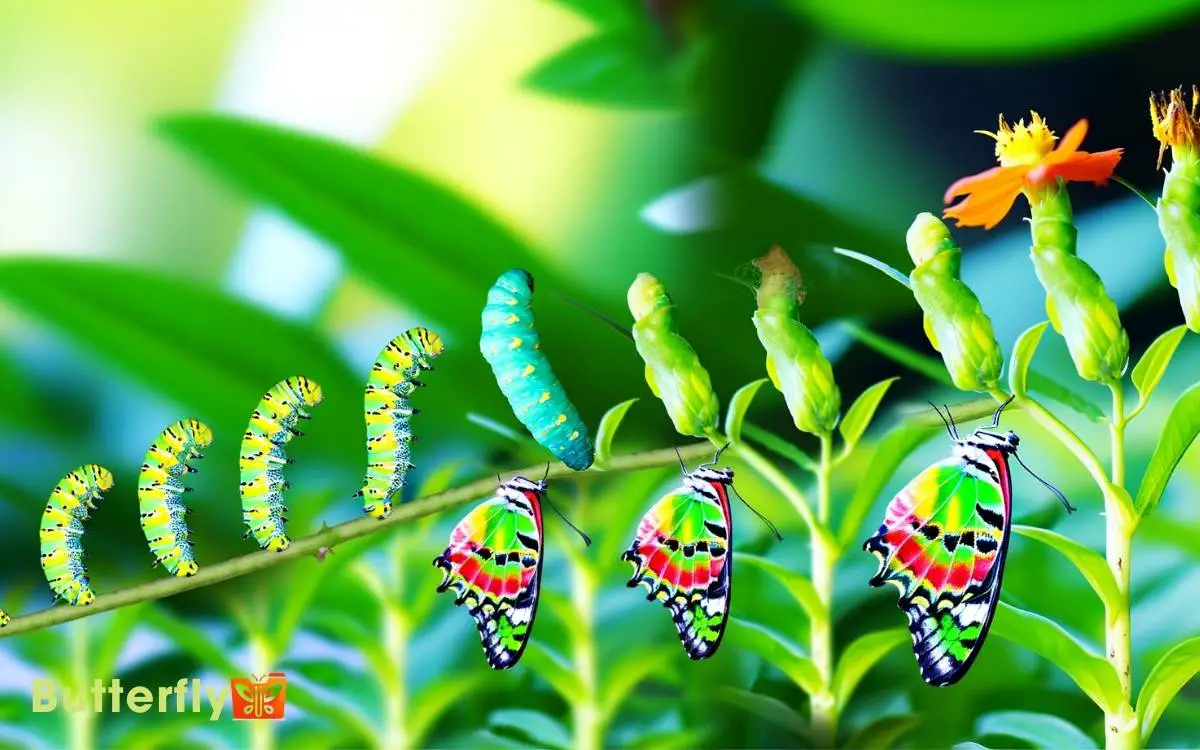
Key Takeaways
Life Cycle Stages
The life cycle of the Painted Lady butterfly consists of four distinct stages: egg, larva (caterpillar), pupa (chrysalis), and adult. Each stage serves an important purpose in the butterfly’s development.
Initially, eggs are laid on host plants, which provide nourishment for the emerging larvae. The larval stage involves rapid growth and multiple molts, during which the caterpillar consumes significant amounts of plant material.
Following the larval phase, the caterpillar forms a chrysalis, entering the pupal stage. During this transformative period, the organism undergoes metamorphosis, reorganizing its structure into that of an adult butterfly.
Egg Stage Duration
Painted Lady butterfly eggs typically hatch within 3 to 5 days, depending on environmental conditions such as temperature and humidity. These variables have a substantial impact on the duration of the egg stage.
For instance:
- Temperature: Higher temperatures accelerate development, while lower temperatures slow it down.
- Humidity: Ideal humidity levels promote proper embryonic growth and prevent desiccation.
- Light: Photoperiods can influence developmental rates, with longer daylight hours potentially speeding up hatching.
- Substrate: The type of plant or surface the eggs are laid on can affect thermal conductivity and moisture retention.
Each of these factors contributes to the precise timing of hatching, ensuring that the Painted Lady butterfly’s development is finely tuned to its environmental conditions.
Understanding these factors is vital for both naturalists and researchers studying these butterflies.
Larval Stage Lifespan
The larval stage of the Painted Lady butterfly spans approximately 7 to 11 days. During this time, the caterpillar undergoes significant growth and development.
Temperature plays a vital role in determining the exact duration, with warmer conditions generally accelerating the process.
This stage is essential for accumulating the necessary energy reserves for metamorphosis.
Growth and Development Period
During the larval stage, the Painted Lady butterfly undergoes significant growth and development, typically spanning a period of 12 to 18 days. During this time, the caterpillar exhibits rapid changes as it prepares for metamorphosis.
Key aspects of this stage include:
- Feeding: The larvae voraciously consume host plants, primarily thistles and nettles, to gather essential nutrients.
- Molting: Larvae molt several times, shedding their exoskeleton to accommodate their increasing size.
- Growth: Each molting phase, known as an instar, marks a significant increase in size and weight.
- Preparation for Pupation: Towards the end of the larval stage, the caterpillars find a suitable location to form a chrysalis, entering the pupal stage.
These processes are vital for the butterfly’s successful progression to adulthood.
Temperature Impact on Lifespan
Environmental factors, particularly temperature, greatly impact the duration of the larval stage in the Painted Lady butterfly‘s lifecycle.
Higher temperatures accelerate larval development, reducing the time required to reach pupation. At ideal temperatures, around 25°C (77°F), the larval stage may last approximately 10-12 days.
Conversely, cooler temperatures slow down metabolic processes, extending the larval stage to several weeks. For instance, at temperatures around 15°C (59°F), larvae may take up to 30 days to complete this phase.
Extreme temperatures, either too high or too low, can be detrimental, potentially causing developmental delays or increased mortality.
Therefore, comprehending the specific temperature ranges that influence larval development is essential for predicting the lifecycle duration and survival rates of the Painted Lady butterfly.
Pupal Stage Timeframe
In the Painted Lady butterfly’s life cycle, the pupal stage typically lasts about 7 to 10 days. During this period, significant transformation occurs within the chrysalis.
Key developments include:
- Metamorphosis: The caterpillar’s tissues break down and reorganize into adult structures.
- Chrysalis Hardening: The outer shell of the chrysalis hardens to protect the developing butterfly.
- Color Change: The chrysalis may change color as the butterfly nears emergence, often becoming darker.
- Internal Development: Wings, antennae, and other adult features form and mature.
This stage is important as it prepares the butterfly for its final, adult phase. Environmental factors like temperature and humidity can influence the exact duration, but the process is generally consistent within the specified timeframe.
Adult Butterfly Lifespan
The Painted Lady butterfly typically has an adult lifespan ranging from two to four weeks. Various factors, such as environmental conditions, food availability, and predation, greatly influence their longevity.
Understanding these factors provides insight into the survival strategies of this species.
Average Lifespan Duration
Adult Painted Lady butterflies typically live for about two to four weeks. During this period, they engage in various essential activities to guarantee the continuation of their species.
- Mating: Finding and selecting mates is pivotal for reproduction.
- Egg Laying: Females lay eggs on host plants to provide a food source for the larvae.
- Feeding: They consume nectar to sustain their energy levels.
- Migration: Some populations undertake long migrations to find suitable environments.
Their short lifespan is packed with these essential processes, all contributing to their life cycle and ecological role. Understanding this duration helps in appreciating the complexity and efficiency of their life stages within a limited time frame.
Factors Affecting Longevity
Various environmental and biological factors greatly impact the Painted Lady butterfly’s adult lifespan. Temperature, food availability, predation, and disease play significant roles.
Ideal temperatures between 20-30°C can prolong life, while extreme heat or cold reduces it. Access to nectar-rich flowers guarantees sufficient energy intake, whereas scarcity leads to starvation.
Predators like birds and spiders pose constant threats, shortening their lives. Additionally, bacterial, viral, and fungal infections can drastically decrease longevity.
| Factor | Impact on Lifespan |
|---|---|
| Temperature | Extreme temperatures reduce lifespan |
| Food Availability | Scarcity leads to starvation |
| Predation | Increased predation shortens life |
| Disease | Infections decrease longevity |
Understanding these factors aids in conservation efforts and ensuring their survival.
Factors Affecting Longevity
Several environmental and biological factors greatly impact the lifespan of the Painted Lady butterfly. Weather conditions, availability of food sources, and predation all play crucial roles in determining how long these butterflies survive. Additionally, painted lady butterfly migration can influence their lifespan, as long-distance travel requires significant energy and exposes them to various risks. Despite these challenges, their strong adaptability helps them thrive in diverse environments.
These factors include:
- Temperature: Higher temperatures can accelerate their metabolism, leading to a shorter lifespan, while cooler temperatures may prolong it.
- Predation: Predators such as birds and spiders have a substantial impact on reducing their lifespan through predation.
- Availability of Food: Access to nectar and suitable host plants for larvae is essential. Limited food sources can lead to malnutrition and reduced longevity.
- Disease and Parasitism: Bacterial, viral infections, and parasitic organisms can significantly shorten their lifespan.
Understanding these factors helps entomologists and conservationists develop strategies to protect and prolong the lives of these butterflies. Effective habitat management and conservation efforts can mitigate some of these detrimental effects.
Conclusion
In the grand tapestry of life, the painted lady butterfly‘s journey is brief yet vibrant. From the egg, symbolizing potential, through the hungry caterpillar stage, representing growth, to the chrysalis, embodying transformation, each phase is a dance of nature’s precision.
As an adult, its fleeting days reflect the ephemeral beauty of existence. Various factors influence its lifespan, but regardless, the painted lady’s life cycle remains a proof of nature’s intricate and rhythmic design.

